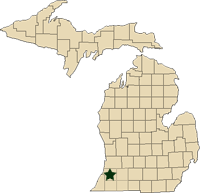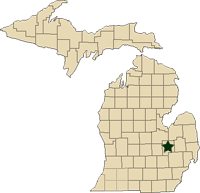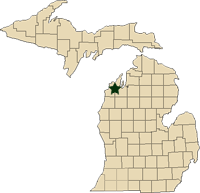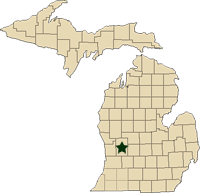Michigan apple maturity reports – September 14, 2011
Each week, MSU Extension educators test apples for maturity in their region and report the status.
This week’s regional reports:
- Southwest Michigan - Mark Longstroth, Bill Shane, Diane Brown
- Southeast Michigan - Bob Tritten and Debbie Clark
- Northwest Michigan - Nikki Rothwell and Karen Powers
- Grand Rapids Area – Phil Schwallier, Amy Irish-Brown, Denise Ruwersma
Southwest Michigan – Bill Shane, Mark Longstroth, Diane Brown Michigan State University Extension
|
This is the second weekly apple maturity report for southwest Michigan. The samples for these reports are collected primarily in Berrien and Van Buren counties. The maturity is only a broad indication of trends for this area. Individual orchards may differ from these results.
General comments
Summary of Berrien County area apple maturity samples taken September 9 and 12, 2011.
|
Variety |
Firmness lbs pressure (range) |
Starch (range) |
Brix (range) |
|
Gala |
18.3 (16 – 20.7) |
7.1 (4.2 – 8) |
12.8 (11.4 – 14.3) |
|
Honeycrisp |
16.5 (15.3 – 17) |
6 (3.8 – 7.2) |
12.9 (12.3 – 13.4) |
|
Empire |
17.7 (16.7 – 18.9) |
2.7 (2 – 4.8) |
11.2 (11.4 – 12.2) |
|
Jonagold |
18.3 (16.6 – 20.3) |
3.6 (2 – 6.8) |
12.2 (11.8 – 12.8) |
|
Jonathan |
18.1 (17 – 19) |
3.1 (1.4 – 4.6) |
11.8 (9.2 – 12.9) |
|
Golden Delicious |
18.5 (17.1 – 19.3) |
1.6 (1 – 2) |
11.9 (11.4 – 13.2) |
Gala (nine sample sites)
Similar to last week, flesh firmness is mainly averaging above 17 pounds in the excellent range for long-term controlled atmosphere storage. And like last week, starch conversion and removal readings are testing mature to over-mature. Brix are averaging 12.8 compared for 13.3 degrees. Background color is cream white with a yellow hue. Some cracking in the stem bowl region and some skin waxiness has been noticed, typical of mature fruit.
The general predicted peak harvest date by MSU for Berrien County this year was September 8. Harvesting of Gala is progressing rapidly in the region. Growers will need to examine fruit harvested closely to make sure that Gala testing well-mature are routed to short term storage and earlier sales and consumption.
Honeycrisp (six sample sites)
The earlier heat caused some sunburn and other skin defects. Fruit firmness is averaging 16.7 compared to 15.7 pounds for last week, ranging from the category of excellent for long-term controlled atmosphere storage down to the short-term storage CA storage category. Starch conversion and removal is quite advanced, with an average of 6, all in the mature range. Brix is averaging 12.9 degrees. The apparent rise in firmness is because samples picked last week tended to be the riper fruit on the trees. Fruit deeper in the canopy and on trees with heavier crops and on sites with heavier soils will be behind in maturity development.
The generalized predicted harvest date for Honeycrisp for Berrien County for 2011 is September 17, with the long-term normal date of September 16. Honeycrisp is moving ahead of the 2011 prediction and about five days ahead of normal. Harvest is underway in some area orchards, with the majority of harvesting expected for this and next week.
Empire (five sample sites)
Firmness average is 17.7 pounds (excellent firmness, with some sites below the firmness needed for export market to England) and starch removal index average is 2.7, with sites ranging from immature to mature. The brix is averaging 11.2 degrees. Harvest for taffy apples has been underway for over a week. Harvest for domestic fresh market sales can be delayed in most orchards. The estimated peak harvest date for Empire destined for long term CA storage for the Benton Harbor region is September 21.
Jonathan (eight sample sites)
Firmness is averaging 18.1 pounds, all in the excellent range, with starch conversion averaging 3.1, ranging from immature to mature. Brix averages 11.8. Post-bloom fire blight has reduced the southwest Michigan Jonathan apple crop this year. Harvest for the fresh market can be delayed in most orchards to wait for better size, skin color and flesh maturity. The estimated peak harvest date for Jonathan destined for long term CA storage for the Benton Harbor region is September 26.
Golden Delicious (six sites)
This is the first quick peek to see how this variety is doing. Firmness is averaging 18.5 pounds (excellent firmness) and starch removal index is 1.6, all in the immature range, with brix average of 11.9. Harvest of Golden Delicious for the fresh market can be delayed, based on these tests. The estimated peak harvest date for Golden Delicious destined for long-term CA storage for the Benton Harbor region is October 1.
Apple maturity trends for southwest Michigan. Each dot is the average for an orchard based on a 10 apple sample.
Samples were taken in Berrien and Van Buren counties.
Click here to view larger image.
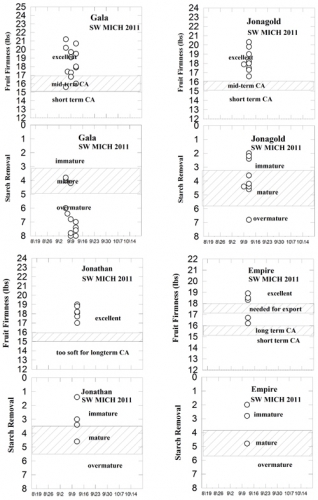
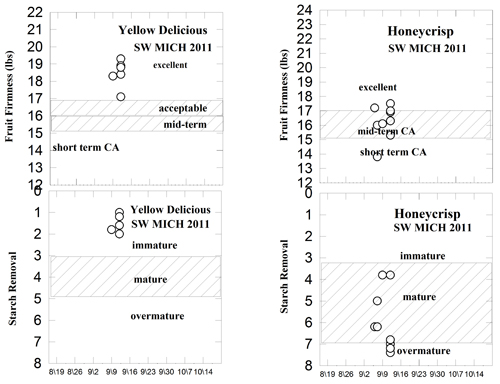
Contact MSU fruit educator Bill Shane at the Southwest Michigan Research and Extension Center at 269-944-1477 ext. 205 if you would like to have samples from your farm tested for maturity. See the MSU Extension News for Agriculture website for more information, including reports from other regions, and the MSU apple website for information about apple maturity and apples in general.
This report and project is made possible by the support of our sponsors, which include Valent Biosciences, Michigan Apple Committee, Michigan State Horticultural Society, MSU’s AgBioResearch and Michigan State University Extension. Southwest Michigan growers providing apples include Grandview Orchards, Mammoth Farms, Oak Hill, Bixby Orchards, Weber Farms, Meachum Farms, Kevin Winkel Farms, Weckwerth Farms, Willmeng Farms, and Czuba Farms.
Southeast Michigan – Bob Tritten and Debbie Clark, Michigan State University Extension
|
This is the second southeast Michigan apple harvest report for the season. Apple harvest is now in full swing. I appreciate several of you responding to my report last week by offering suggestions and comments that can help to improve it. For this week’s report I have added ethylene data to Table 1 and took out the background color data, as I find it was not as useful to growers as the ethylene data.
General comments
Apple growers are finishing up harvest of Gala and at the same time are starting to pull off some McIntosh as well as doing the first picking of Honeycrisp. Apples seem to be picking out a little bit longer than what growers had originally anticipated. Most growers are sharing with me that they are harvesting between 60 and 80 percent of their “normal” apple crop.
This week I sampled eight varieties, starting with Gala and moving all the way through Golden Delicious. Physiologically, some blocks of Gala are over-mature now and some are still right in the middle of the harvest window. McIntosh are mature right now, even though the color is poor in many blocks. They continue to push themselves off the limb. Honeycrisp also tested to be mature and a few being over mature at this time.
Table 1. Apple maturity in East Michigan for apples harvested on September 12.
|
Variety |
% Fruits with Ethylene over 0.2 ppm (Range) |
Color (Range) |
Firmness Lbs (Range) |
Starch (Range) |
Brix % |
|
Gala |
93% (80-100%) |
85% (75-95%) |
16.4 lbs (14.8-17.5) |
5.7 (4.2-7.6) |
11.8% |
|
McIntosh |
55% (0-100%) |
68% (63-73%) |
14.3 lbs (12.8-15.7) |
5.3 (3.8-6.3) |
11.3% |
|
Honeycrisp |
95% (80-100%) |
65% (40-79%) |
15.7 lbs (14.7-16.5) |
5.7 (5.3-6.0) |
13.3% |
|
Jonathon |
40% (20-60%) |
66% (59-72% |
17.8 lbs (17.6-17.9) |
2.9 (2.7-3.0) |
11.4% |
|
Jonagold |
13% (0-20%) |
51% (37-75%) |
17.7 lbs (17.1-18.6) |
3.2 (2.9-3.4) |
12.3% |
|
Empire |
20% (0-40%) |
72% (61-87%) |
15.7 lbs (15.5-16.1) |
2.4 (2.1-2.6) |
9.7% |
|
Cortland |
3% (0-60%) |
63% (56-70%) |
16.7 lbs (16.4-17.0) |
1.5 (1.4-1.6) |
10.2% |
|
Golden Delicious |
13% (0-40%) |
0% (0-0%) |
17.2 lbs (16.4-18.5) |
2.1 (1.8-2.6) |
12.0% |
Individual variety results
Gala were sampled for the second week of the fall harvest season, and for the most part varieties that were tested this week were also the same ones that were sampled last week. Growers have pretty much harvested all of the earlier maturing strains of Gala. There is some stem end cracking on Gala. Ninety-three percent of the fruit are showing internal ethylene levels greater than 0.2 parts per million (ppm). The fruit color has improved to 85 percent, and the fruit firmness remains firm at 16.4 lbs. The starch index has jumped from 2.4 last week to 5.7 this week, and the brix has remained about the same, testing at 11.8 percent this week. Growers are moving through Galas very quickly and hopefully will be done in the next few days.
McIntosh were sampled for the second week of the season. Fifty-five percent of the fruit tested are showing internal ethylene levels greater than 0.2 ppm. The color has improved to 68 percent and the firmness remains excellent at 14.3 lbs. The starch removal has jumped dramatically. Last week’s average was 3.2 and this week’s is 5.5. Fruit remains a bit on the sour side, however, with a brix of 11.3. Most of the early and mid season maturing strains of McIntosh are ready for long term storage. I would suggest that growers may wait a few more days for short term storage McIntosh, as much colder weather is predicted and should help color a great deal. Color has been the major challenge on McIntosh so far this year.
Honeycrisp were sampled for the second week of the season, with 95 percent of the fruit showing internal ethylene levels greater than 0.2 ppm. The color is improved to 65 percent. The change in color was dramatic from last week to this week in most blocks of Honeycrisp. The fruit remains firm at 15.7 lbs and starch removal has jumped dramatically from 2.5 last week to 5.7 this week. The fruit are fairly sweet at 13.3 percent brix.
Honeycrisp is a very challenging apple to grow. This year, some blocks of Honeycrisp have about 5 to 10 percent of black rot affecting the fruit. There is also a fair amount of fruit that is cracked from sunburn. In the last week, I’ve started to see very small cracks develop on the cuticle or the skin of Honeycrisp. These cracks are very recent and range from 0.25 to 0.75 inches in length. This fruit that is splitting open is a physiological problem or disorder caused by such poor growing conditions early in the season that didn’t foster the development of a hardy or flexible cuticle or skin that allowed the fruit to swell here at harvest. For this reason, I am encouraging growers to pick Honeycrisp a little bit earlier than what they have in the past. I don’t know as though this will eliminate this recent fruit cracking problem, but it may lessen it some.
Careful sorting needs to be done on Honeycrisp this year. Most blocks of Honeycrisp will only be picked two times this year.
Jonathon were sampled for the first time of the season with 40 percent of the fruit showing internal ethylene levels greater than 0.2 ppm. The color remains good on Jonathon at 66 percent and the fruit are very firm at 17.8 lbs. Fruit starch removal index is 2.9 with a brix of 11.4 percent. Jonathon are not ready for harvest at this time. I think they are moving along fairly quickly and most likely will be ready for harvest in about a week or so.
Jonagold were sampled for the first time this season, with only 13 percent of the fruit showing internal ethylene levels greater than 0.2 ppm. Fruit are fairly good color at 51 percent and remain very firm at 17.7 lbs. The starch removal is a surprising 3.2 and a brix of 12.3 percent. I have seen other years where Jonagold have high starch index values early in the harvest window. I think that Jonagold are most likely a little under a week away from being physiologically mature, but look for more details in next week’s report.
Empire were sampled for the first week of the season with 20 percent of the fruit showing internal ethylene levels greater than 0.2 ppm. The fruit has colored well at 72 percent and are firm at 15.7 lbs. The starch removal index is 2.4, indicating that they are immature at this time. They are also tart, with a brix of only 9.7 percent. Empire are most likely close to two weeks away from being ready for harvest.
Cortland were sampled for the first week of the season, with both samples being the Red Cort strain. Only 3 percent of the fruit showing internal ethylene levels greater than 0.2 ppm. Color is good for this time of the season at 63 percent and very firm at 16.7 lbs. Starch removal index is only 1.5, indicating that they are a long way from harvest. Look for more details in next week’s report.
Golden Delicious was the last new variety sampled for the week; I am trying to get an early read on its maturity. There is only 13 percent of the fruit showing internal levels greater than 0.2 ppm. The background color is still poor and fruit remains very firm at 17.2 lbs. The starch removal index is testing at 2.1 with a brix of 12.0. I think that Golden Delicious are two-plus weeks away from being ready for harvest.
Table 2. Predicted harvest dates.
|
Full bloom date |
Original Predicted Harvest Dates |
Revised Predicted Harvest Dates |
|||||||
|
Station |
McIntosh |
Jons |
Reds |
McIntosh |
Jons |
Reds |
McIntosh |
Jons |
Reds |
|
Deerfield |
5/13 |
5/15 |
5/17 |
9/15 |
9/29 |
10/5 |
9/20 |
10/4 |
10/10 |
|
Romeo |
5/19 |
5/21 |
5/21 |
9/17 |
10/2 |
10/8 |
9/22 |
10/7 |
10/13 |
If you have any questions regarding this apple maturity report or apple harvest in southeast Michigan, email me or don’t hesitate to email me or call my office (810-244-8555) or my cell (810-516-3800).
This report and project is made possible by the support of our sponsors, which include Valent Biosciences, Michigan Apple Committee, Michigan State Horticultural Society, MSU’s AgBioResearch and Michigan State University Extension. Southeast Michigan apple growers that are providing apples on a weekly basis include Spicer Orchards in Hartland, Erwin Orchards in South Lyon, Westview Orchards in Romeo and Hy’s Cider Mill in Romeo. Many thanks to the support of these growers.
Northwest Michigan – Nikki Rothwell and Karen Powers, Michigan State University Extension
|
General Comments
The Northwest Michigan Horticulture Research Station (NWMHRS) will be testing apples for maturity for 2011. If growers are interested in having fruit tested, they should drop off a 10 to 12 apple sample at the NWMHRS on Mondays. Fruit should be picked randomly from the outside portion of the trees and should be large in size and free of blemishes with the stem attached.
With the lack of rainfall in July and August, fruit size is smaller than in past years. Rain is expected this week and temperatures are predicted to cool down for the coming four days; daytime highs will reach only into the 50s.
Color has improved on most varieties, but many varieties still need improvement. Cool nights should help with color, but the forecast predicts cloudy days. Quality of apples remains high across the region and insect pressure has been low in the past few weeks. Overall brix in the fruit tested is in the 10-11 range.
Summary of northwest Michigan apple maturity samples taken on September 12, 2011
|
Variety |
Color % (range) |
Firmness lbs. pressure (range) |
Starch (range) |
Brix (range) |
|
Gingergold (3) |
21 (9.5-34) |
17 (15.3-19.6) |
3.4 (1.9-6.2) |
11.7 (11.2-12.3) |
|
Gala (3) |
81 (67.5-96.5) |
21 (19.5-21.9) |
1 |
10.7 (9.8-11.5) |
|
McIntosh (7) |
69 (64.5-86) |
15.9 (14.1-18.7) |
2.6 (1-4.5) |
10.9 (10.6-11.7) |
|
Honeycrisp (4) |
69 (59-81.5) |
17.6 (16.4-20) |
2.2 (1.7-3.9) |
11.6 (10.2-13.7) |
NWMHRS predicted harvest dates for 2011
|
Full Bloom |
Predicted Harvest |
||||||||||
|
McIntosh |
Jonathan |
Red Delicious |
McIntosh |
Jonathan |
Red Delicious |
||||||
|
23-May |
27-May |
27-May |
24-Sep |
10-Oct |
16-Oct |
||||||
|
Dates Compared to Normal |
Dates Compared to 2010 |
||||||||||
|
McIntosh |
Jonathan |
Red Delicious |
McIntosh |
Jonathan |
Red Delicious |
||||||
|
-2 |
-4 |
1 |
-20 |
-23 |
-23 |
||||||
Gingergold. Approaching mature (three samples). Fruit firmness is still fairly high at an average of 17.0 pounds, but the starch removal index shows variability between samples with two samples around two while the third sample shows the fruit approaching over maturity. Most Gingergold harvest is wrapping up around the region, but the starch removal of some fruit shows that apples are not quite mature; some of the samples still tasted starchy.
Gala. Immature (three samples). Firmness of Galas has not changed in the past week and most samples still have firmness’s in the 19-pound pressure range. Starch index levels also remain constant. This variety seems to be slower to ripen than other varieties. Color has improved over the last week by about 10 percent.
McIntosh. Approaching mature (seven samples). Fruit firmness has dropped over the last week and in some blocks, firmness has decreased by 4 pounds. There was some variability by block in Macs, where some of the apples have a starch index of mature, 4.5, to other blocks that are showing immature fruits, 1-2.5. Brix levels are similar to last week and apples still eat on the green side. Most MacIntosh around the region are still colored at about 70 percent and we are predicted to harvest this variety in one and a half weeks. At this time of the season, Macs typically have more color than we are seeing this year.
Honeycrisp. Immature (four samples). Firmness in Honeycrisp has not changed much over the last week in most blocks. However, some blocks are approaching maturity with starch index readings at 3.9. Again, there is variability in ripening across blocks. Color has improved quite a bit over the last week, from 52 percent color to an average of 69 percent. This variety needs multiple pickings over several weeks for premium quality fruit.
|
Grand Rapids Area – Phil Schwallier, Amy Irish-Brown, Denise Ruwersma, Michigan State University Extension
General comments
In the Grand Rapids area, apple maturity continues to move along a little more quickly than expected. We continue to notice that apples seem to have an earlier and higher ethylene expression this year.
Until we get samples from the Hart and Shelby area, growers can expect harvest dates for that area to be behind the Grand Rapids area using this guide: along the lakeshore, approximately six days behind Grand Rapids; areas inland, about four days behind; and add another two days behind for those blocks with a very heavy crop.
Summary of Grand Rapids apple maturity samples tested September 13, 2011.
|
Variety |
Avg. Ethylene (ppm) |
% Fruits with Ethylene over 0.2 ppm |
Color % (range) |
Firmness lbs pressure (range) |
Starch (range) |
Brix (range) |
|
Blondee |
1.1 |
90% |
0% |
18.4 (14 - 22.3) |
6 (3 - 8) |
12.1 (11.5 - 13) |
|
Brookfield Gala |
2.92 |
100% |
93% (80 -100%) |
19.3 (15 -22.5) |
3.6 (2 - 6) |
13.9 (13 - 15) |
|
Buckeye Gala |
1.73 |
100% |
96% (85- 100%) |
19.1 (15.6 - 22.5) |
4.1 (2 - 7) |
12.5 (11 - 14) |
|
Ruby Mac |
0.47 |
40% |
96% (95 -100%) |
14.6 (11.2 -20) |
4.2 (3 - 5) |
12.7 (12 - 14) |
|
Honeycrisp |
1.87 |
100% |
61% (45 - 80%) |
13.6 (12 - 16.4) |
6.6 (5 - 7) |
11 (10.5 - 11.5) |
|
Jonagold (Jonagored) |
0.11 |
0% |
40% (5 - 60%) |
16.2 (13.5 - 19.9) |
3.9 (2 - 6) |
10.7 (10 - 12) |
|
RubyJon |
0.33 |
40% |
99% (95 -100) |
16.4 (14 - 19.2) |
3.3 (2 - 6) |
11.4 (11 - 12) |
Blondee
This new cultivar is a sport of Gala and appears to ripen slightly ahead of the more common Gala cultivars. This could be due to the overall youngness of trees at this time. It should be noted that Blondee is now past its prime in the Grand Rapids area for long-term storage and is quickly moving into a short-term storage window.
Gala
Color is improving Gala strains, but is still quite delayed by Retain applications. Gala are moving very quickly through the maturity stages. Most non-Retain treated strains are still in the long-term storage stage, but that is expected to change quickly. Retain treated fruits will start to color up later this week, especially with the cooler temperatures forecasted. There is some waxiness and shoulder splitting being reported in Gala. Continue to watch Gala closely and don’t wait too long to harvest them.
McIntosh
All Mac strains are just at the beginning stage of maturity for long-term storage in the Grand Rapids area. Ethylene continues to be lower than expected with only 40 percent of fruits tested being over 0.2 ppm. Pressure readings are still good at 12.7 pounds. Color has improved a bit from last week, but could be better. Brix levels have improved from 12 last week to 12.7 this week. There is not much drop being reported in Mac blocks, but be wary of storms and get them off if there is a threat for winds.
Honeycrisp
Honeycrisp are just moving into the mature range. Starch readings took a big jump from solid readings of 1 (no starch clearing) last week to readings of 5 to 7 this week. Brix levels are good, but not quite excellent. Brix should improve greatly in the next week. Color picking of Honeycrisp is just beginning. Any early Honeycrisp that were harvested in the Grand Rapids area before now were immature and not really fit for the retail markets. Retailers were clamoring for them, but we can’t forget that the 2010 harvest date of September 6 for Honeycrisp in the Grand Rapids area was two weeks ahead of the normal date of September 18. The 2011 predicted optimal harvest date for Honeycrisp is September 20. It’s looking like Honeycrisp maturity is running a little bit ahead of this predicted date, but only by three to five days.
Jonagold
We tested Jonagold (Jonagored) for the first time this week. They are still immature, but we were surprised to see a background level of measurable ethylene already present. Internal ethylene is still below 0.2 ppm for all fruits tested; color is poor as is brix readings. The predicted harvest date for Jonagold in the Grand Rapids area is September 30. It appears that Jonagolds are at least 10 to 14 days away from any early harvest for long-term storage.
RubyJon
The predicted harvest date for Jonathan in the Grand Rapids area is September 29. Our first samples of RubyJon are indicating this to be a good average target date.



 Print
Print Email
Email